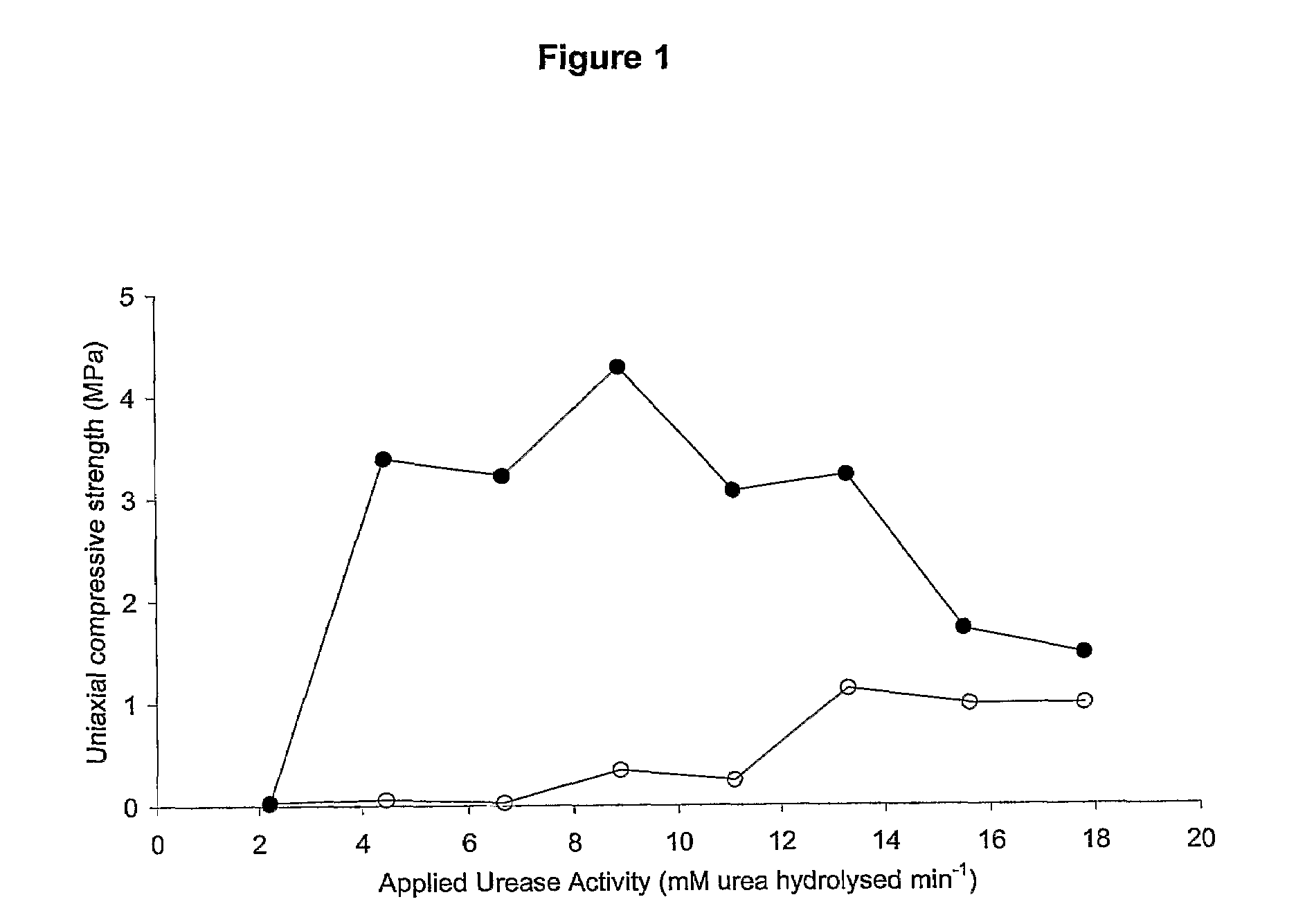Microbial Biocementation
a biocementation and microorganism technology, applied in soil conditioning compositions, solid waste management, sustainable waste treatment, etc., can solve the problems of insufficient strength of cement, insufficient degree of control of process, and particularly useful, so as to increase the resistance of offshore structures, reduce dust levels, and increase the resistance to petroleum borehole degradation
- Summary
- Abstract
- Description
- Claims
- Application Information
AI Technical Summary
Benefits of technology
Problems solved by technology
Method used
Image
Examples
example 1
Biocementation in Si-Sand
[0113]Materials & Methods
[0114](A) Application of Cementation Reactants into the Core
[0115]Cores for cementation consisted of 50 ml plastic syringes that were dry packed with 300 μm Si-sand under continuous vibration to give an even density. Cores were then up-flushed with water and tapped to remove air pockets. After flushing with water, the volume occupied by the sand decreased due to the lubrication effect between the sand particles and the stopper was adjusted to maintain a confining pressure.
[0116]Ca / urea solution and cells were premixed immediately before injection into the core by pouring both liquids into a single vessel and twice drawing and expelling the liquid with a second 50 ml syringe, to ensure proper mixing. One and a half times the pore volume was flushed in to ensure full displacement of water.
[0117](B) In-situ Cementation Measurements
[0118]Strength was measured by sending ultrasound waves through the diameter of each core at three position...
example 2
Biocementation in Other Sands
[0150]Materials & Methods
[0151](A) Vegemite Acetate Medium
[0152]Vegemite acetate medium consisted of 13.5 g.L−1 Vegemite, from which the solids were removed by gravity settling followed by decanting the upper fraction and 150 mM acetate added as glacial acetic acid. The pH was adjusted to 7 with 6 M NaOH.
[0153]For the inoculum cultivation, the medium was sterilised and 10 g.L−1 urea was added by sterile filtration, post-sterilisation. For the pilot-scale cultivation, the medium was not sterilised and urea was added without sterile filtration.
[0154](B) 10 L Pilot-Scale Inoculum Cultivation
[0155]A pilot-scale inoculum was grown under sterile conditions in a 10 L stirred tank reactor (Chemap, Germany), at 30° C. with a starting pH of 8.25.
[0156](C) 100 L Pilot-Scale Cultivation
[0157]The pilot-scale cultivation was conducted under non-sterile conditions in a 120 L custom-built fibreglass airlift reactor (courtesy of Andrew Brown & Co., Perth), with a working...
example 3
Enhancing Penetration Depth for Biocementation
[0179]Materials / Methods
[0180]Bacteria were cultured in the presence of 6 mM Ca2+ and then 650 mL of the bacterial culture (urease activity approximately 10 mM urea hydrolysed / min) was applied to a 1 m sand column by up-flushing under a pressure of 7.5 psi for 11:39 min (1.4 L / hr). The column with the bacterial cells inside was kept at room temperature for a period of 48 hours after which 1.25M Ca2+ and 1.7M urea was up-flushed into the column.
[0181]Results
[0182]A uniform strength was obtained. The uniformity of the cemented column was confirmed by ammonium analysis see FIG. 13. Two photographs of the columns after cementation are attached as FIGS. 14A and 14B.
PUM
| Property | Measurement | Unit |
|---|---|---|
| Temperature | aaaaa | aaaaa |
| Pressure | aaaaa | aaaaa |
| Mass | aaaaa | aaaaa |
Abstract
Description
Claims
Application Information
 Login to View More
Login to View More - R&D
- Intellectual Property
- Life Sciences
- Materials
- Tech Scout
- Unparalleled Data Quality
- Higher Quality Content
- 60% Fewer Hallucinations
Browse by: Latest US Patents, China's latest patents, Technical Efficacy Thesaurus, Application Domain, Technology Topic, Popular Technical Reports.
© 2025 PatSnap. All rights reserved.Legal|Privacy policy|Modern Slavery Act Transparency Statement|Sitemap|About US| Contact US: help@patsnap.com



